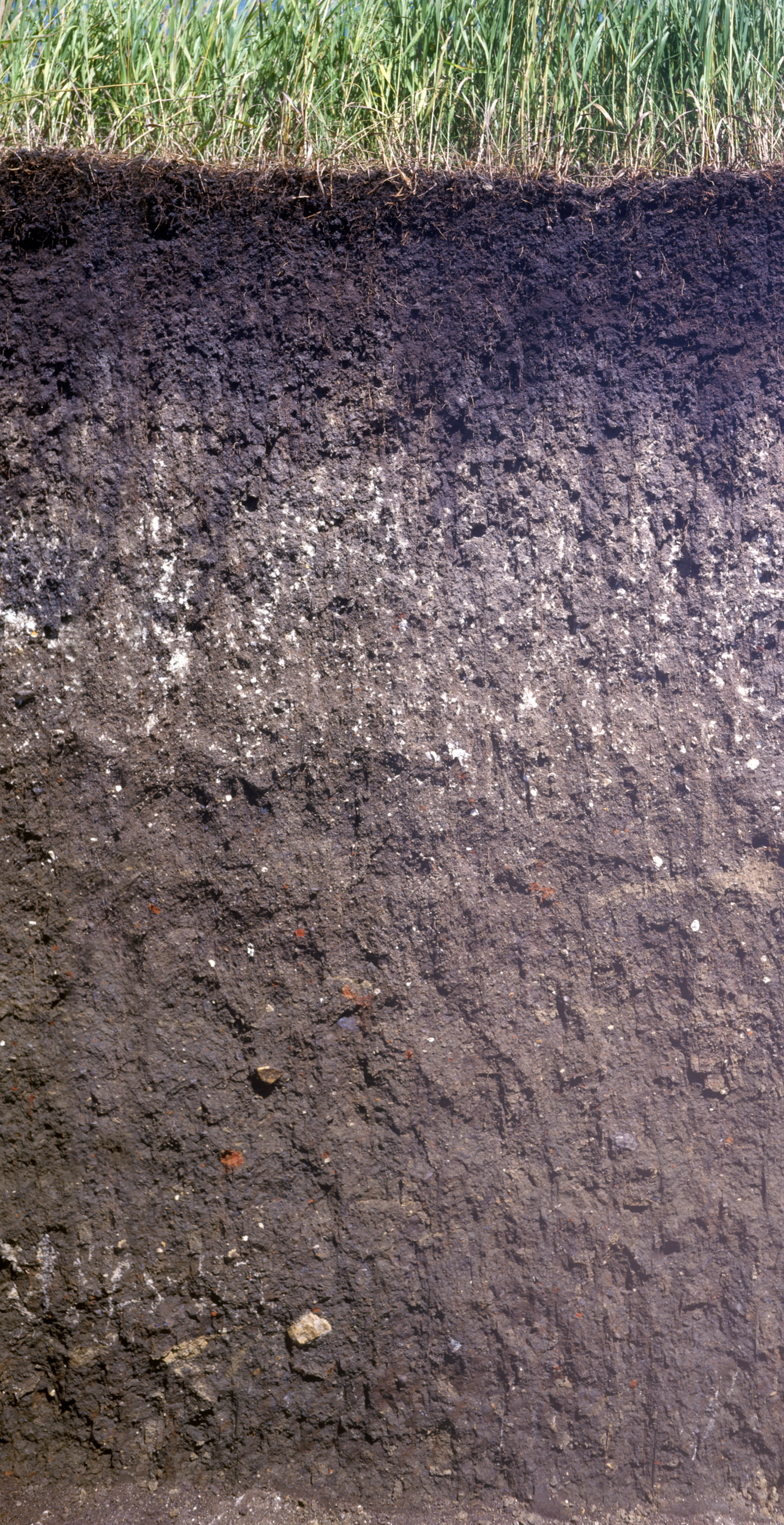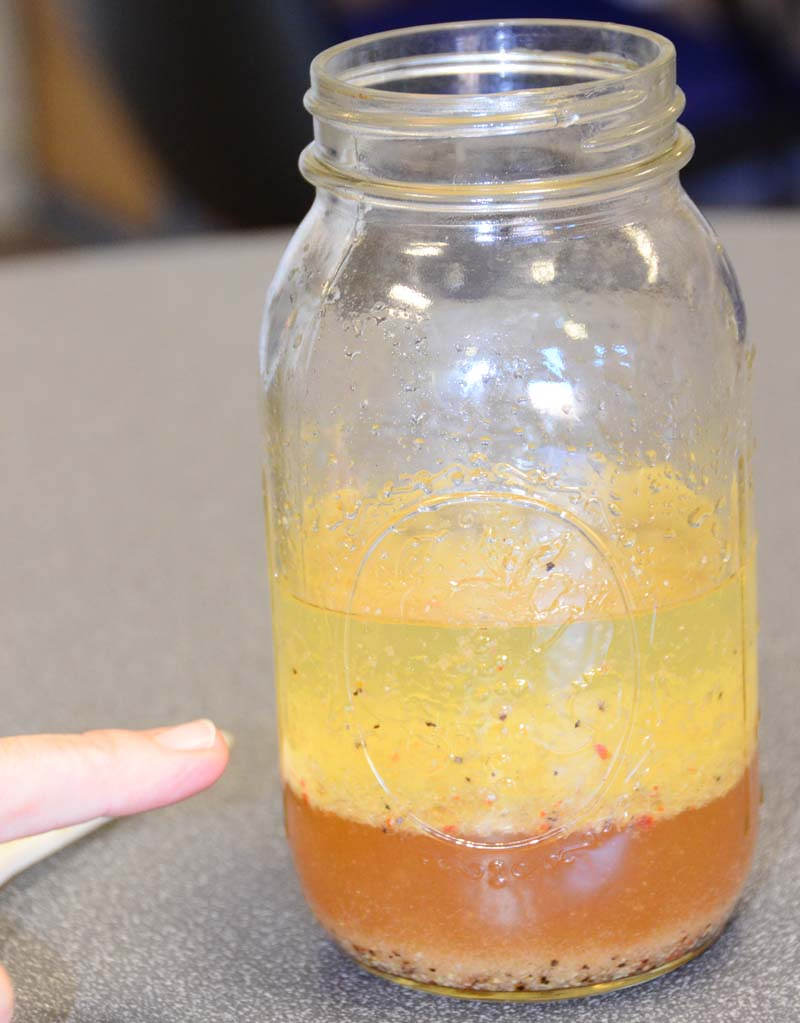 Relevancy and Engagement
dc.agclassroom.org
Relevancy and Engagement
dc.agclassroom.org
Soil Formation & Edible Horizons
Grade Level
Purpose
Students discover what a soil profile looks like, investigate the composition of soil, and explore the five soil-forming factors and soil horizons. Grades 3-5
Estimated Time
Materials Needed
Engage:
Activity 1: Soil Horizons Forming in the Blink of an Eye
- Soil Profile Photo
- 1 Italian salad dressing spice packet
- 1 cup oil
- 1 cup vinegar
- 1 clear jar
- Spoon
- Watch with a second hand
- Soil Formation & Edible Horizons activity sheet
Activity 2: Gallery Walk
- Soil Horizon Cards
- CLORPT Cards
- Soil Formation & Edible Horizons activity sheet
Activity 3: Edible Soil (per pair of students)
- 1 resealable plastic bag with 4 chocolate cookies
- 1 resealable plastic bag with 2 chocolate graham crackers
- 1 chocolate pudding cup
- 1 vanilla pudding cup
- 2 clear plastic cups
- 1 paper cup with 1/3 cup of chocolate chips
- marker
- Spoons
- Gummy Worms
Vocabulary
soil: a mixture of minerals, organic matter, water, and air, which forms on the land surface and can support the growth of plants
soil horizon: a layer of soil that forms from physical, chemical, and biological properties resulting from soil forming processes; each layer is distinguishable by certain characteristics
soil profile: vertical cross section of the soil from the ground surface to the underlying bedrock; composed of horizons
Background Agricultural Connections
All soil is made up of solid materials (sand, silt, clay) and organic matter, just in different quantities depending on their location and CLORPT factors. CLORPT stands for Climate, Organisms, Parent Material, Time and Topography. These five soil factors affect all of the soils on the planet and describe the physical characteristics that have contributed to the development of soils over time.
Climate
Temperature and rainfall affect the color of soil, acidity levels, and presence of organic matter. Leaching, or the removal of soil materials, occurs during high rainfall by water that is flowing through the soil. Soils in climates that are warm and moist have lots of organic matter and support plant growth, opposite of hot and dry climates.
Organisms
Organisms in the soil, such as plants and animals, play an important role in increasing organic matter and humus in the soil. Roots on plants help to mix soil particles and break up large rocks in the soil, providing channels for movement of water and air. The foliage of the plant decays and adds organic matter to the soil. Animals within the soil, such as earthworms, insects, and burrowing animals, help in continued mixing of the soil and carry plant debris down to the topsoil.
Parent Material
Parent materials are weathered geological matter that has formed the soil that we see. Most parent materials are a type of bedrock such as sandstone or basalt. Sediments that are translocated by water, wind, or ice, such as volcanic ash, lake laid silts, dune sand, and glacial gravels, are other parent material types.
Time and Topography
Young soils share similar characteristics and properties with their parent material. As soil gets older and new characteristics are forming, the inherited properties become less and less evident. The position of the landscape causes soil moisture, temperature, and parent material to change. Slopes can cause the collection of water at the bottom with little to no collection at the top. The bottom of the slope can also collect transported materials that may not be present at the top. Directional slopes can also have different temperatures. A north-facing slope could be cooler than a south-facing slope.
A soil horizon is a layer of soil that forms from physical, chemical, and biological properties resulting from soil-forming processes. Each horizon is distinguishable by certain characteristics. A vertical view of the soil that displays the divided layers or horizons is known as a soil profile.
O Horizon – Organic
The O horizon is made up of nearly 100 percent organic material consisting of decaying leaves, twigs, or peat. O horizons usually appear in forest soils or in wet bog and swamp soils.
A Horizon – Surface Layer
The A horizon is often called the top soil. This layer is where most of the organic matter is found (i.e., worms, bugs, plant growth, microscopic organisms, dead organisms, decaying plants). Top soil is the darkest colored and most fertile layer of soil. The depth of this horizon can be a few inches in dry soils or more than 20 in wetter soils. This is the layer of soil where gardeners and farmers plant gardens and crops which provide an ideal environment for the growth of roots.
E Horizon – Eluviation Layer
The E horizon appears light gray or white due to the leaching of iron and organic material. When present, the E horizon is below the O horizon or the A horizon. The E horizon appears in sandy soils and in some wet, silty soils.
B Horizon – Subsoil
The B horizon is usually yellowish brown or reddish brown in color and doesn't contain much organic matter. This layer contains clay, nitrogen, minerals, and salts which have leached from the surface layer. Although it can be rich in minerals, this layer isn't good for growing plants because it lacks organic matter.
C Horizon – Parent Material or Regolith
The C horizon is the substratum layer and has less change than the layers above it. This layer has large deposits of sand, gravel, pebbles, rocks, and even boulders. This layer would support very little plant growth.
Engage
- Show
 the students the Soil Profile Photo.
the students the Soil Profile Photo. - Ask the students, "What is a soil horizon?" After listening to their responses, discuss the following points:
- A soil horizon is a layer of soil that forms from physical, chemical, and biological properties.
- Each layer is distinguishable by certain characteristics.
- Soil horizons form over hundreds, thousands, and even millions of years.
- Before soil horizons form, they start as a mix or jumble of solid and organic materials. Volcanic eruptions or floods are examples of these mixing events. A mass of similarly mixed materials are spewed out and with the passage of time, and the effects of climate, organisms, parent material, time and topography (CLORPT), soil horizons are formed.
- All of the layers put together, like you see in the photo, form a soil profile.
- Explain to the students that they will investigate the composition of soil and explore the five soil-forming factors and soil horizons.
Explore and Explain
Activity 1: Soil Horizons Forming in the Blink of an Eye
- Show
 the students the Soil Profile Photo. Ask, "How long did it take for these soil horizons to form?" Remind the students that soil horizons form over hundreds, thousands, and even millions of years. It is a process we can see after it has happened, but not in action. Explain that they will observe a demonstration that will help them see how horizons are formed—almost like a time-lapse.
the students the Soil Profile Photo. Ask, "How long did it take for these soil horizons to form?" Remind the students that soil horizons form over hundreds, thousands, and even millions of years. It is a process we can see after it has happened, but not in action. Explain that they will observe a demonstration that will help them see how horizons are formed—almost like a time-lapse. - Provide each student with a Soil Formation & Edible Horizons activity sheet.
- Combine the salad dressing spice mix, oil, and vinegar in a clear jar.
- Vigorously stir the salad dressing with a spoon, and watch the dressing mix up. This represents a mixing event such as a volcanic eruption or flooding event.
- Place the dressing where everyone can observe it settle.
- Using a watch, announce the passing of every 30 seconds to the students and have them observe and record their observations on their activity sheet at each interval. Each 30 seconds is equal to approximately 100 years of soil horizon formation. As the dressing settles, it will show "virtual" soil horizons forming.
- Explain to the students that the ingredients in the jar represent the horizons in soil. The spices represent the parent material, the lightest layer represents topsoil, etc.
Activity 2: Gallery Walk
- Using the Soil Horizons Cards and the CLORPT Cards, stage the room with cards hung on the wall in sequential order. The first three cards in each set are identical to provide some background information.
- Have the students partner up. One partner will go to the Soil Horizons Cards and the other will go to the CLORPT Cards. Depending on class size, you may want to have two sets of each of the cards.
- Students should fill in their Soil Formation & Edible Horizon activity sheets with the information they read on the cards. Once they have completed their set of cards and notes, they should meet with their partner and share what they learned, taking notes on their partner’s card sets.
- Once students have collected all of the information, have them answer the review questions in preparation for the classroom discussion.
- Explain how some horizons support plant growth better than others and how the color of the soil signifies the nutrient availability within the soil.
- When looking at a soil profile, how do you distinguish horizons from one another?
Activity 3: Edible Soil Horizons
- Working in partners, one student from each partner group should collect the following supplies:
- 1 resealable plastic bag with 4 chocolate cookies
- 1 resealable plastic bag with 2 chocolate graham crackers
- 1 chocolate pudding cup
- 1 vanilla pudding cup
- 2 clear plastic cups
- 1 paper cup with 1/3 cup of chocolate chips
- marker
- Have the students read through the directions on their worksheet to complete the Edible Soil Horizons. Make sure to remind students that they may not start eating their creation until you have approved their work.
- Have each student raise their hand once their soil profile is complete with labeling for approval from you to eat it.
- Review each soil profile and provide students with a couple of organisms (gummy worms) and a spoon for their soil. Enjoy your soil profile!
Evaluate
After conducting these activities, review and summarize the following key concepts:
- Soil is made up of solid materials (sand, silt, clay) and organic matter.
- Climate, Organisms, Parent Material, Time, and Topography (CLORPT) are factors that affect all of the soil on the planet and describe the physical characteristics that have contributed to the development of soil over time.
- A soil horizon is a layer of soil that forms from physical, chemical, and biological properties resulting from soil-forming processes.
- A vertical view of the soil that displays the divided layers or horizons is known as a soil profile.
Acknowledgements
- Referenced Manual for Judging Oregon Soils for soil information and diagram photos on worksheets.
- Huddleston, J., & Kling, G. F. (1996). Manual for Judging Oregon Soils (6th ed., p. 3). Corvallis, OR: Oregon State Extension Service.
Recommended Companion Resources
- Diary of a Worm
- Dirt: Secrets in the Soil (DVD)
- Dirt: The Scoop on Soil
- Jump Into Science: Dirt
- Mountains of Jokes About Rocks, Minerals, and Soil
- My American Farm
- Nutrients for Life eLessons
- Rocks and Soil
- SOIL Reader
- Soil Health Education Resources
- Soil Painting
- Soil Samples (Soil Texture)
- Soil Science Society of America
- Soil! Get the Inside Scoop
- The Dirt Book: Poems About Animals That Live Beneath Our Feet
- Under Your Feet: Soil, Sand and Everything Underground
- You Wouldn't Want to Live Without Dirt!